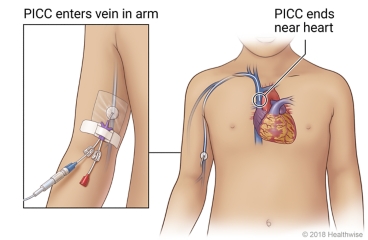Overview

A peripherally inserted central catheter (PICC) is a thin, flexible tube that's used to give medicine, blood products, nutrients, or fluids. One end is put through the skin into a vein in the arm and moved into a large vein near the heart. The other end stays outside the body. It's a type of central vascular access device, or central line.
Your child may have it for weeks or months.
A PICC can be more comfortable for your child because medicines and other fluids go directly into the catheter. That means your child won't be poked with a needle every time. A PICC also can be used to do blood tests.
A PICC may have two or three ends, called lumens, so that your child can get more than one type of fluid or medicine at a time. The end of each lumen is covered with a cap. It may allow you to help treat your child at home.
The doctor may give your child a sedative to make your child feel relaxed. Your child may feel a little pain when the doctor gives the sedative or numbs your child's arm. The doctor will then put the PICC in your child's arm. The doctor may use stitches or other devices to hold the PICC in place on the arm.
After the procedure, the site may be sore for a day or two. Your child may have a large bandage or other covering to help keep the PICC clean and in place.
Follow-up care is a key part of your child's treatment and safety. Be sure to make and go to all appointments, and call your doctor if your child is having problems. It's also a good idea to know your child's test results and keep a list of the medicines your child takes.
How can you care for your child at home?
- Always wash your hands, and have your child wash their hands, before you touch the PICC.
- Check it every day for symptoms of infection. These include pain, tenderness, swelling, drainage, pus, redness, and warmth on the skin near the PICC.
- Make sure that your child doesn't get the device wet. When your child showers, cover the device with something waterproof, such as plastic wrap. Your child should not go swimming with a PICC.
- If your child's PICC has a clamp, keep it clamped when it's not in use.
- Fasten or tape the PICC to your child's body to prevent it from dangling and being pulled on. Remind your child not to play with the PICC or touch the open ends of the PICC when the cap is off. You may need to repeat the reminder a few times.
- Avoid clothing that rubs or pulls on your child's PICC. Have your child be careful wearing jewelry, such as necklaces, that can catch on the PICC.
- Talk to your child's doctor about what activities they can do.
- Show your child how to avoid bending or crimping the PICC.
- Never use scissors, knives, pins, or other sharp objects near the PICC or other tubing.
- Clamp off the PICC if it breaks. Then take your child to the doctor as soon as possible.
- Your child's PICC will need regular flushing to keep it open. The care team may do this for you. You or a caregiver can be taught to do this at home. Be sure to follow those instructions carefully.
- Don't have your child's blood pressure taken on the arm with the catheter.
- Consider having your child wear a medical alert bracelet and carry a medical alert card. These will tell health care providers about the port in case your child needs emergency care.
Changing the dressing
- If your child has a gauze dressing, change it every 2 days. If it's a clear plastic dressing, change it every 7 days. Also change the dressing if it is wet, bloody, loose, or dirty. Your child's care team may also give you specific instructions on how and when to change the dressing.
- Be sure you have all your supplies ready. These include medical tape, a surgical mask, clean disposable gloves, sterile gloves, the dressing, an applicator, alcohol pads, and skin-protecting swabs. The names and brands of the items will vary.
How to change the dressing
Here are some basic tips for how to change the dressing.
- Prepare a clean work area, such as a clean counter in your bathroom. Put your supplies on the clean area.
- Wash your hands with soap and water for at least 20 seconds. Be sure to wash between your fingers and under your fingernails. Dry your hands with paper towels.
- Put on the surgical mask.
- Put on the clean disposable gloves. Loosen and slowly peel away the old dressing while holding the PICC securely in place. You may need to use an adhesive remover if the dressing doesn't come off easily.
- Look at the area carefully for redness, swelling, drainage, pus, tenderness, or warmth. If you notice any of these, contact the doctor.
- Remove your disposable gloves.
- Wash your hands again (as instructed in step 2), and put on the sterile gloves.
- Clean the area. Use the applicator the care team gave you, or use alcohol pads. Clean in an up-and-down or side-to-side motion. When you have finished, let the area dry for about 30 seconds.
- Clean the outside of the PICC.
- Use an alcohol pad to hold the PICC in place. Use another alcohol pad to gently clean the outside of it.
- Start from where the PICC is at the skin and gently clean toward the cap.
- If the PICC has 2 or 3 lines, use a fresh pad to clean each line.
- Swab the edges of the cleaned area with the skin protector.
- Remove the backing from the clear plastic dressing. Place the dressing over the PICC and the skin around it. If you are using a gauze dressing, be sure it covers the skin around the PICC and secure it with tape.
- Tape or fasten the PICC to your child's body so it won't dangle or get pulled on.
- Dispose of the old dressing and any used materials as instructed.
- Wash your hands again with soap and water.
How do you flush the line?
A PICC line must be flushed to keep it clear of blood and prevent clotting. Do this as often as your child's care team tells you to. If the PICC has more than one line (lumen), flush them in the same order each time.
Depending on the type of PICC your child has, you will flush it with either heparin or saline solution. Your child's care team will probably give you supplies and instructions on how to flush it. A nurse may come to your home to help at first.
Your child will usually lie down when you flush the line. This helps prevent air from getting into the vein.
Be sure you have all your supplies ready. These may include the heparin or saline solution, syringes, needleless injection cannulas, alcohol pads, clean disposable gloves, and a disposal box. What you need will vary with the type of PICC your child has. You may have syringes that are already filled with the solution (preloaded).
Preparing the syringe
Flushing the line
When should you call for help?
Call 911 anytime you think your child may need emergency care. For example, call if:
- Your child passes out (loses consciousness).
- Your child has trouble breathing.
- Your child has chest pain, is short of breath, or coughs up blood.
Contact your doctor now or seek immediate medical care if:
- Your child has swelling in the face, chest, neck, or arm on the side where the PICC is.
- Your child has signs of a blood clot, such as bulging veins in the neck.
- Your child's PICC is leaking, cracked, or clogged.
- You feel resistance when you inject medicine or fluids into your child's PICC.
- Your child's PICC is out of place. This may happen after severe coughing or vomiting, or if you or your child pulls on it.
- Your child has symptoms of infection, such as:
- Increased pain, swelling, warmth, or redness.
- Red streaks leading from the area.
- Pus or blood draining from the area.
- A fever.
Watch closely for changes in your child's health, and be sure to contact your child's doctor if your child has any problems.
Where can you learn more?
Go to http://www.healthwise.net/patientEd
Enter P165 in the search box to learn more about "Peripherally Inserted Central Catheter (PICC) in Children: Care Instructions".
Current as of: March 26, 2025
Author: Ignite Healthwise, LLC Staff
Clinical Review Board
All Ignite Healthwise, LLC education is reviewed by a team that includes physicians, nurses, advanced practitioners, registered dieticians, and other healthcare professionals.

